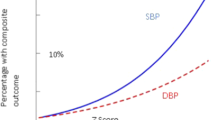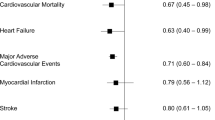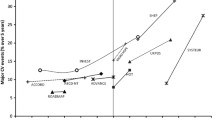Summary
The Hypertension in the Very Elderly Trial (HYVET) is a multicentre, open, randomised, controlled trial. The aim of this trial is to investigate the effect of active treatment on stroke incidence in hypertensive patients over the age of 80 years. Secondary end-points include total cardiovascular mortality and morbidity.
Entry criteria include a sustained sitting systolic blood pressure of 160 to 219mm Hg plus a sustained sitting diastolic pressure of 95 to 109mm Hg. Also required is a standing systolic blood pressure of at least 140mm Hg. Patients must give their informed consent, and be free of congestive heart failure requiring treatment, gout, renal failure or a recent cerebral haemorrhage. Patients are to be randomised to 3 groups — (i) no treatment; (ii) treatment with a diuretic [bendroflumethiazide (bendrofluazide)]; or (iii) treatment with an angiotensin converting enzyme (ACE) inhibitor (lisinopril).
Starting dosage for bendroflumethiazide and lisinopril is 2.5 mg/day. In order to achieve goal sitting systolic and diastolic blood pressures (< 150/80mm Hg), a doubling of the dosage is allowed. Furthermore, slow release diltiazem (120 mg/day increasing to 240 mg/day if required) may be added to the medication of the actively treated groups. These drugs have been chosen as inexpensive and appropriate representatives of their therapeutic classes.
700 patients in each group (a total of 2100) will be sufficient to detect a 40% difference in cerebrovascular events between no treatment and active treatment (α = 0.01, 1−β = 0.90). These numbers will also detect a difference in total mortality of 25% and in cardiovascular mortality of 35%.
The pilot phase of the trial has been started with support from the British Heart Foundation. Centres which are interested in taking part should contact C. J. Bulpitt or any of the other authors.
Similar content being viewed by others
References
Office of Population Censuses and Surveys. Mortality statistics 1986. London: HMSO, 1988. Series DH2 No. 13
Agner E. Natural history of angina pectoris, possible previous myocardial infarction and intermittent claudication during the eighth decade: a longitudinal epidemiologic study. Acta Med Scand 1981; 210: 271–6
World Health Organisation. Preventing disability in the elderly. Copenhagen: WHO Regional Office for Europe, 1982. EURO Reports and Studies, No. 65
Shekelle RB, Ostfeld AM, Klawans HL. Hypertension and risk of stroke in an elderly population. Stroke 1974; 5: 71–5
Garland C, Barrett-Connor E, Suarez L, et al. Isolated systolic hypertension and mortality after age 60 years: a prospective population based study. Am J Epidemiol 1983; 118: 365–76
Proportional hazards analysis of risk factors for coronary heart disease in individuals aged 65 years or older: the Framingham Heart Study. J Am Geriatr Soc 1988; 36: 1023–8
Miall WE, Chinn S. Screening for hypertension: some epidemiological considerations. BMJ 1974; 3: 595–600
Mattila K, Haavisto M, Rajala S, et al. Blood pressure and survival in the very old. BMJ 1988; 296: 887–9
Langer RD, Ganiate TG, Barrett-Connor E. Paradoxical survival of elderly men with high blood pressure. BMJ 1989; 298: 1356–7
Bulpitt CJ, Fletcher AE. Aging, blood pressure and mortality. J Hypertens 1992; 10 Suppl. 7: S45–9
Bulpitt CJ, Fletcher AE. Prognostic significance of blood pressure in the very old: implications for the treatment decision. Drugs Aging 1994; 5(3): 184–191
Coope JN, Warrender TS. Randomised trial of treatment of hypertension in elderly patients in primary care. BMJ 1986; 293: 1145–51
Medical Research Council Working Party. MRC trial of treatment of hypertension in older adults: principal results. BMJ 1992; 304: 405–12
Amery A, Birkenhäger W, Brixko P, et al. Efficacy of antihypertensive drug treatment according to age, sex, blood pressure and previous cardiovascular disease in patients over the age of 60. Lancet 1986; 2: 589–92
Dahlof B, Lindholm LH, Hanson L, et al. Morbidity and mortality in the Swedish trial in old patients with hypertension (STOP-Hypertension). Lancet 1991; 338: 1281–5
SHEP Co-operative Research Group. Prevention of stroke by antihypertensive drug treatment in older persons with isolated systolic hypertension. JAMA 1991; 265: 3255–64
Emeriau JP. What is the clinical relevance of isolated systolic hypertension. Drugs Aging 1992; 2: 147–52
Amery A, Birkenhäger WH, Brixko P, et al. Mortality and morbidity results from the European Working Party on High Blood Pressure in the Elderly trial. Lancet 1985; 1: 1349–54
Dahlof BL, Ekbom T, Oden AS, et al. Stroke: prevention in elderly hypertensives not solely dependent on reduced blood pressure — insights from STOP-Hypertension. Presentation at 14th Scientific Meeting of ISH, Madrid 1992
Petrie JC, O’Brien ET, Littler WA, et al. British Hypertension Society recommendations on blood pressure measurement. BMJ 1986; 293: 611–5
Hodkinson HM. Evaluation of a mental test score for assessment of mental impairment in the elderly. Age Ageing 1972; 1: 233–8
Amery A, Birkenhäger W, Bulpitt CJ, et al. Syst-Eur: a multicentre trial on the treatment of isolated systolic hypertension in the elderly — objectives, protocol, and organization. Aging Clin Exp Res 1991; 3: 287–302
World Health Organisation ICD10. International statistical classification of diseases and related health problems, vol 1. 10th rev. Geneva: WHO, 1992
Aho K, Harmsen P, Hatano S, et al. Cerebrovascular disease in the community: results of a WHO collaborative study. Bull World Health Organ 1980; 58: 113–30
Genton E, Barnet HJM, Fields WS, et al. Cerebral ischemia: the role of thrombosis and antithrombotic therapy. Joint Committee for Stroke Resources. Stroke 1977; 8: 150–75
Heyman A, Leviton A, Millikan CH, et al. Transient focal cerebral ischemia: epidemiological and clinical aspects. Stroke 1977; 5: 277–87
Rose GA, Blackburn H. Méthodes d’enquête sur les maladies cardio-vasculaires. Genève: Organisation Mondiale de la Santé; 1969
Grimley Evans J. Blood pressure and stroke in an elderly English population. J Epidemiol Community Health 1987; 41: 275–82
Pocock SJ. Group sequential methods in the design and analysis of clinical trials. Biometrika 1977; 64: 191–9
O’Brien PC, Flemming TE. A multiple testing procedure for clinical trials. Biometrics 1979; 35: 549–56
Carlsen JE, K0ber L, Torp-Pedersen C, et al. Relation between dose of bendrofluazide, antihypertensive effect, and adverse biochemical effects. BMJ 1990; 300: 975–8
Bulpitt CJ. A risk-benefit analysis for the treatment of hypertension. Postgrad Med J 1993; 69: 764–74
Dollery C, Boobis AR, Burley B, et al. Bendrofluazide. In: Therapeutic drugs, vol. 1. Edinburgh: Churchill Livingstone, 1991: B19–B26
Dollery C, Boobis AR, Burley B, et al. Hydrochlorothiazide. In: Therapeutic drugs, vol. 1. Edinburgh: Churchill Livingstone, 1991: H50–H54
Dollery C, Boobis AR, Burley B, et al. Lisinopril. In: Therapeutic drugs, vol. 2. Edinburgh: Churchill Livingstone, 1991: L39–L43
Whelton A, Miller WE, Dunne B, et al. Once daily lisinopril compared with twice daily captopril in treatment of mild to moderate hypertension: assessment of office and ambulatory blood pressure. J Clin Pharmacol 1990; 30: 1074–80
Whelton A, Dunne B, Glazer N, et al. Twenty four hour blood pressure effect of once daily lisinopril, enalapril, and placebo in patients with mild to moderate hypertension. J Hum Hypertens 1992; 6: 325–31
Pool JI, Gennari J, Goldstein R, et al. Controlled multicentre study of antihypertensive effects of lisinopril, hydrochlorothiazide, and lisinopril and hydrochlorothiazide in the treatment of 394 patients with mild to moderate essential hypertension. J Cardiovasc Pharmacol 1987; 9 (3 Suppl.): S36–S42
Bolzano K, Arriaga J, Bernai R, et al. The antihypertensive effect of lisinopril compared to atenolol in patients with mild to moderate hypertension. J Cardiovasc Pharmacol 1987; 9 (13 Suppl.): S43–7
Chrysant SG, Chrysant C, Trus J, et al. The antihypertensive effectiveness of lisinopril and metoprolol alone and in combination with other drugs. Curr Ther Res 1989; 45: 238–44
Pannier BE, Garabedien VG, Madonna O, et al. Lisinopril v atenolol: decrease in systolic versus diastolic blood pressure with converting enzyme inhibition. Cardiovasc Drugs Ther 1991; 5: 755–82
Lees KR, Reid JL. Lisinopril and nifedipine: no acute interaction in normotensives. Br J Clin Pharmacol 1988; 25: 307–13
Morlin C, Bagliro H, Boeijinga JIC, et al. Comparative trial of lisinopril and nifedipine in mild to severe essential hypertension. J Cardiovasc Pharmacol 1987; 9: 48–52
Laher MS. Lisinopril in elderly patients with hypertension, long term effects on renal and metabolic function. Drugs 1990; 39 (2 Suppl.): 55–63
Laher MS, Natin D, Rao SK, et al. Lisinopril in elderly patients with hypertension. J Cardiovasc Pharmacol 1987; 9 (3 Suppl.): 69–71
Herpin D, Conte D. Assessment of the antihypertensive effect of lisinopril using 24 hour ambulatory monitoring. J Hum Hypertens 1989; 3: 11–5
Zachariah PK, Bonnel G, Chrysant SG, et al. Antihypertensive efficacy of lisinopril: ambulatory blood pressure monitoring. Am J Hypertens 1988; 1: 274S–9S
Dahlöf B, Pennert K, Hansson L. Reversal of left ventricular hypertrophy in hypertensive patients — meta-analysis of 109 treatment studies. Am J Hypertens 1992; 5: 95–100
Hansson L, Svensson A, Dahlöf B, et al. Drug treatment of hypertension. In: Robertson JIS, editor. Handbook of hypertension: clinical aspects of essential hypertension, vol. 15, Amsterdam: Elsevier, 1992: 655–708
Hansson L, Dahlöf B, Himmelman A, et al. ACE inhibitors in treatment of essential hypertension. In: Nicholls G, Robertson JIS, editors. Renin textbook, vol.91, London: Gower Medical, 1992: 1–24
Marner R, Vandapapeliere P, DeVriese G. Safety and efficacy of lisinopril in elderly patients with mild to moderate hypertension. J Hum Hypertens 1989; 3: 163–7
Murray NH. Duration of ACE inhibitor inhibition: implication for tolerability. Cardiology 1991; 79 (1 Suppl.): 22–9
Rush JE, Lyle PA. Safety and tolerability of lisinopril in clinical trials. Am J Med 1988; 85(Suppl. 3B): 99–107
Moyse C, Higgins TJC. Safety of long term use of lisinopril for congestive heart failure. Am J Cardiol 1992; 70: 91C–97C
Dollery C, Boobis AR, Burley B, et al. Diltiazem (hydrochloride). In: Therapeutic drugs. Edinburgh: Churchill Livingstone, 1991; 1: D143–D148
Kates RE. Calcium antagonists: pharmacokinetic properties. Drugs 1983; 25: 113–24
Smith MS, Verghese CP, Shand DG, et al. Pharmacokinetic and pharmacodynamic effects of diltiazem. Am J Cardiol 1983; 51: 1369–74
Walker G. APBI Data Sheet Compendium 1993–1994. Association of British Pharmaceutical Industries. London: Datapharm Publications, 1993
Schulte KL, Meyer-Sabellek WA, Distler A, et al. Long term treatment with diltiazem and nifedipine in essential hypertension. J Hypertens 1984; 2: 93
Yamakado T, Oonishi N, Kando S, et al. Effects of diltiazem on cardiovascular responses during exercise in systemic hypertension and comparison with propranolol. Am J Cardiol 1983; 53: 1023–7
Letzel H, Bluemner E. Dose-response curves in antihypertensive combination therapy: results of a controlled clinical trial. J Hypertens 1990; 8 (4 Suppl.): S83–S86
Hansson L, Dahlöf B. Calcium antagonists in the treatment of hypertension: state of the art. J Cardiovasc Pharmacol 1990; 15 (4 Suppl.): S71–S75
McGraw BF, Walker ST, Hemberger JA, et al. Clinical experience with diltiazem in Japan. Pharmacotherapy 1982; 2: 156–61
Waller PC, Inman WHW. Diltiazem and heart block. Lancet 1981; 1: 617
Prida XE, Gelman JS, Feldman RL, et al. Comparison of diltiazem and nifedipine alone and in combination in patients with coronary artery spasm. J Am Coll Cardiol 1987; 9: 412–9
Klinke WP, Kvill L, Dempsey EE, et al. A randomised double blind comparison of diltiazem and nifedipine in stable angina. J Am Coll Cardiol 1988; 12: 1562–7
Pepine CJ, Joyal M, Cremer KF, et al. Haemodynamic effects of glycerin combined with diltiazem in patients with coronary artery disease. Am J Med 1984; 76(Suppl. 6A): 47–51
Pertz JE, Borda L, Schuchlei BR, et al. Inotropic and chronotropic effect of vasodilators. J Pharmacol Exp Ther 1982; 221: 609–13
Walsh RA, Bradke FR, O’Rourke RA. Differential effects of systemic and intracoronary calcium channel blocking agents on global and regional left ventricular function in conscious dogs. Am Heart J 1981; 102: 341–50
Walsh RA, Porter CB, Starling MR, et al. Salutary haemodynamic effects of intravenous and oral diltiazem in severe congestive cardiac failure. Circulation 1982; 66 (Suppl. 2, Pt 2): II–138
Bulpitt CJ. In: Bulpitt CJ, editor. Randomised controlled clinical trials. The Hague: Martinus Nijhoff, 1983: 64–7
Bulpitt CJ. Definition, prevalence and incidence of hypertension in the elderly. In: Amery A and Staessen J, editors. Handbook of hypertension: hypertension in the elderly, vol. 12, Amsterdam: Elsevier, 1989: 155–69
Sever P, Beevers G, Bulpitt CJ, et al. Management guidelines in essential hypertention: report of the second working party of the British Hypertension Society. BMJ 1993; 306: 983–7
Joint National Committee on Detection, Evaluation, and Treatment of High Blood Pressure. The fifth report of the Joint National Committee on Detection, Evaluation, and Treatment of High Blood Pressure. Arch Intern Med 1993; 153: 154–83
WHO/ISH. 1993 Guidelines for the management of mild hypertension: memorandum from a World Health Organization/International Society of Hypertension Meeting. J Hypertens 1993; 11: 905–18
Staessen J, Fagard R, Lijinen P, et al. Review of the major intervention trials in the elderly. Cardiovasc Drugs Ther 1990; 4: 1237–42
Medical Research Council Working Party. MRC trial of treatment of mild hypertension: principle results. BMJ 1985; 2: 97–104
Author information
Authors and Affiliations
Rights and permissions
About this article
Cite this article
Bulpitt, C.J., Fletcher, A.E., Amery, A. et al. The Hypertension in the Very Elderly Trial (HYVET). Drugs & Aging 5, 171–183 (1994). https://doi.org/10.2165/00002512-199405030-00003
Published:
Issue Date:
DOI: https://doi.org/10.2165/00002512-199405030-00003




